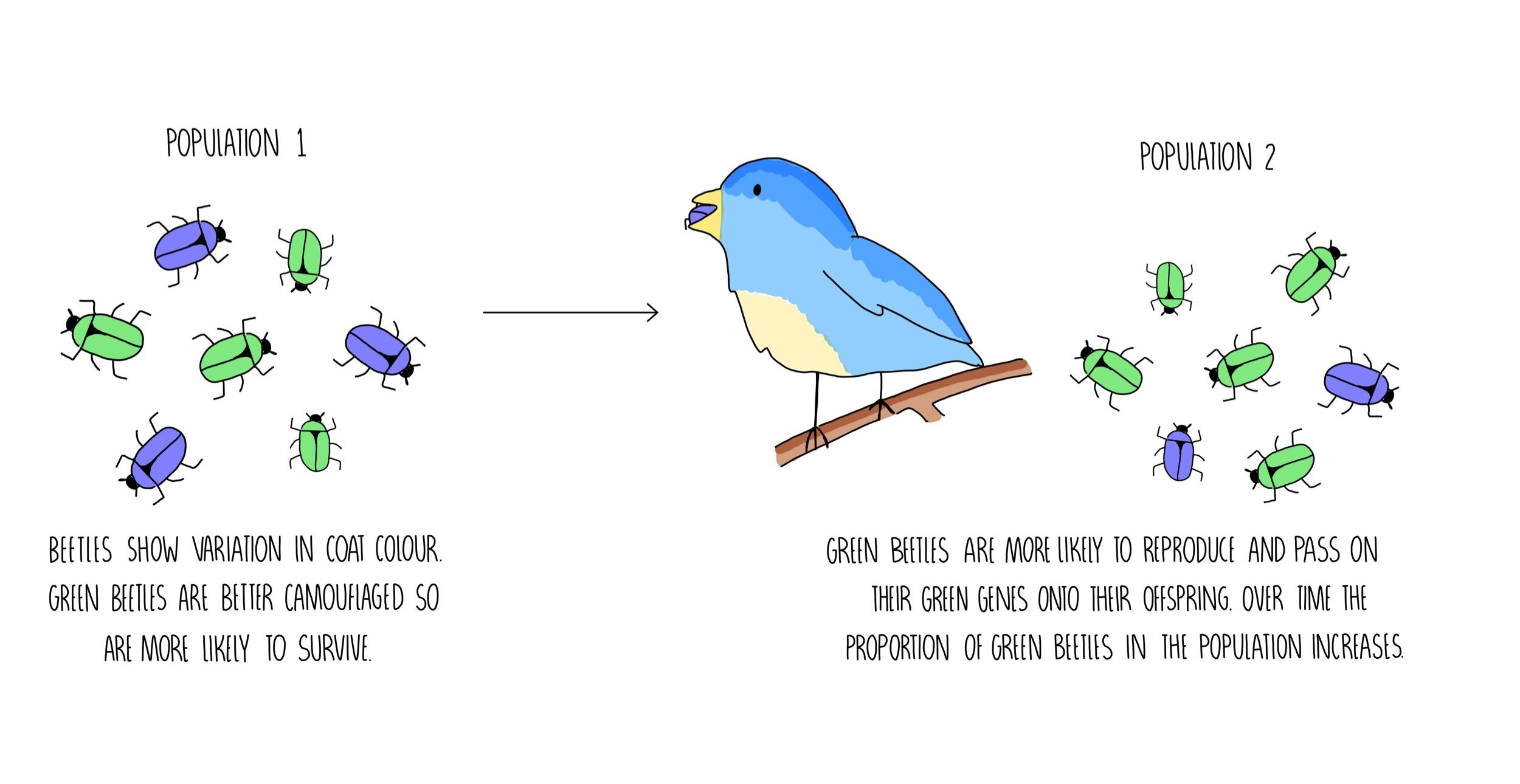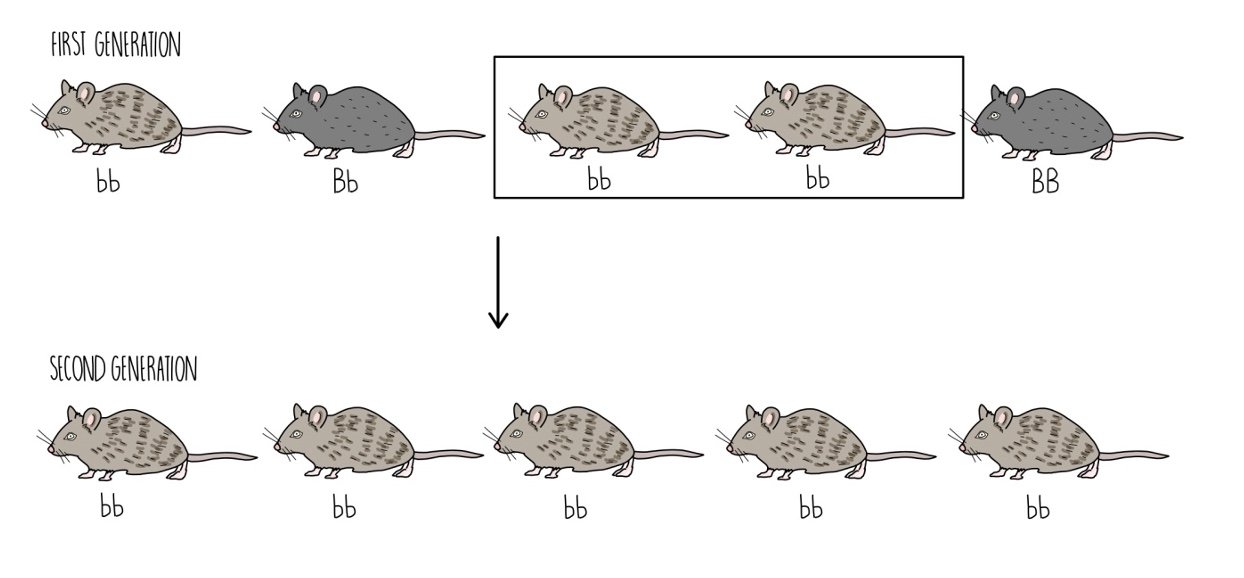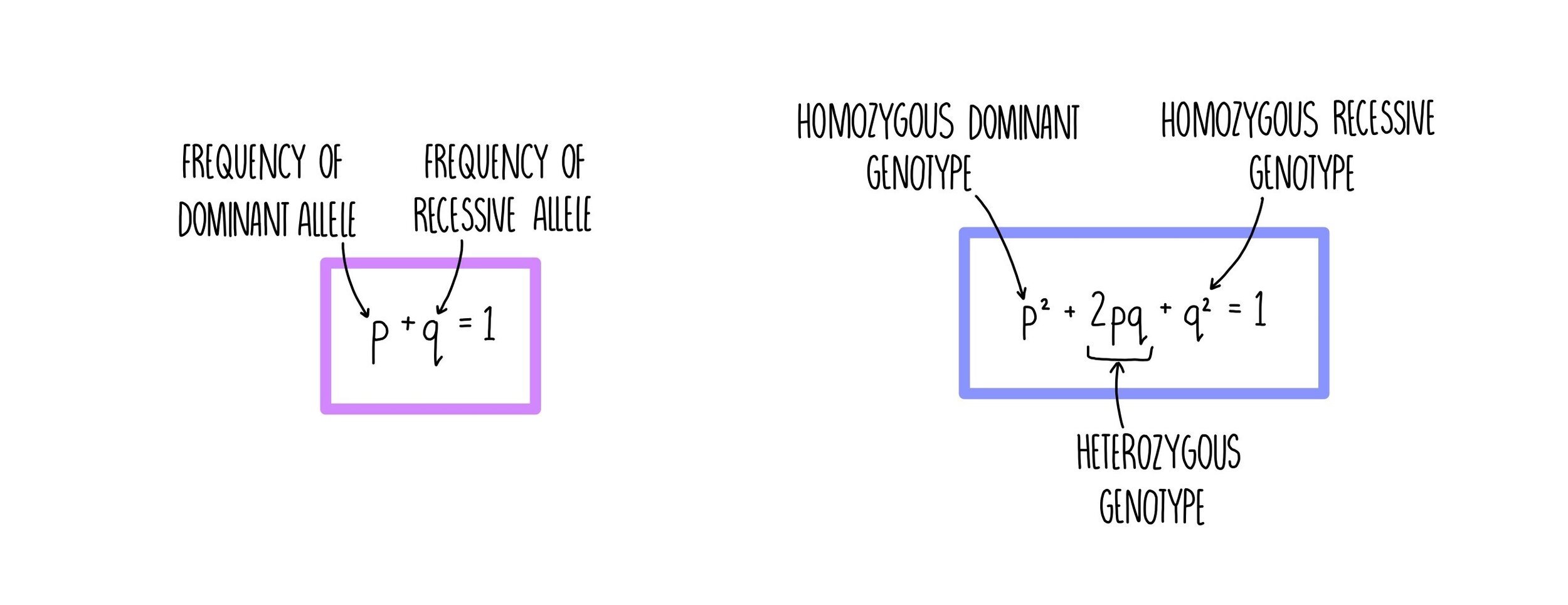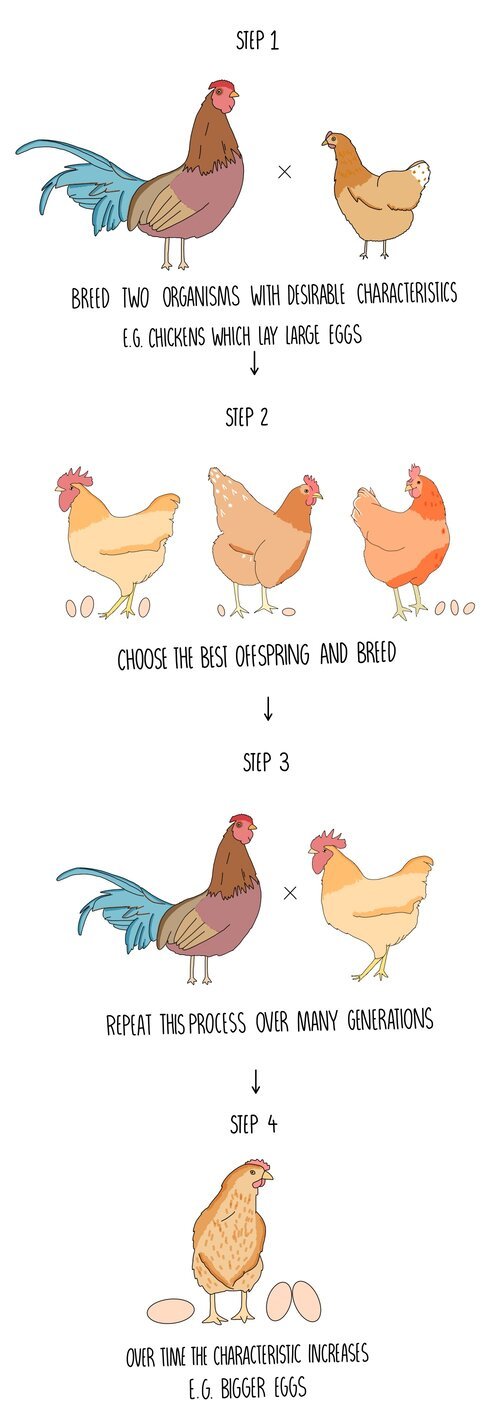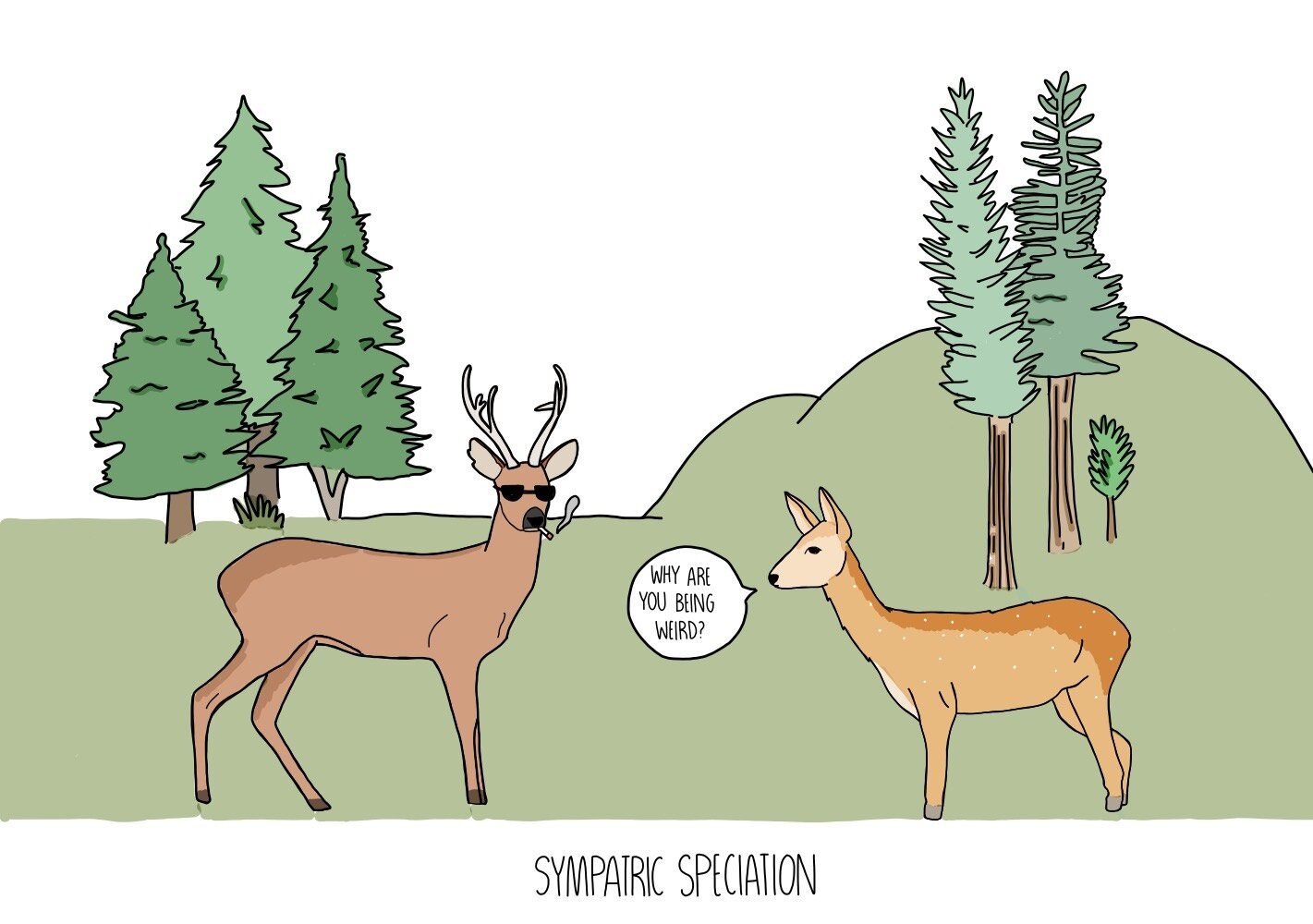Evolution
Evolution is a change in allele frequency
The gene pool is the term used to describe all the alleles within a population. The higher the genetic diversity, the larger the gene pool. When organisms migrate into the population (gene flow), the gene pool gets bigger. Over time, the frequency of different alleles changes in response to changes in the environment – this is the basis of evolution. For example, as global temperatures rise, we expect to see alleles that allow plants to tolerate the heat to become more common.
Natural Selection
Natural selection is the process by which species evolve. Evolution is the change in allele frequency within a population over time. It can be broken down in the following steps:
There is variation within the population (because different individuals have different alleles). Gene mutations cause new alleles to appear in the population - some of these may be harmful but some may be beneficial.
Organisms with alleles which give them characteristics most suited to their environment are more likely to survive to reproductive age and pass on their genes to their offspring, compared to individuals which do not have the beneficial allele.
A greater proportion of individuals in the next generation have inherited the advantageous allele. These organisms are also more likely to survive and reproduce. They will also pass on the advantageous allele to their offspring.
Over time, the frequency of the advantageous allele increases in the population - this is evolution.
Types of selection
Natural selection can occur in different ways – it might push a phenotype in a particular direction (e.g., necks of giraffes increasing in length) or it may make the mean phenotype (e.g., birth weight) more common.
Directional selection
Alleles for an extreme phenotype are more likely to be selected for
Usually triggered by a change in the environment.
E.g., development of antibiotic resistance in bacteria
A mutation in a bacterium enables it to develop resistance to an antibiotic.
When antibiotic is used (the selection pressure), the resistant bacterium survives while the rest are killed.
The bacterium can grow without competition and reproduce, passing on its resistance allele to its offspring
This produces a population of bacteria which carry the antibiotic resistance allele
Stabilising selection
Alleles for an average phenotype are more likely to be selected for.
Occurs when environmental conditions remain stable
Reduces the range of possible phenotypes
E.g., human birth weight
Underweight babies are less likely to survive as they lose a lot of body heat.
Overweight babies are more likely to lead to childbirth complications.
Alleles for a mean birth weight are more likely to survive and reproduce, passing on their average weight alleles onto their offspring
Genetic drift
Genetic drift describes the random changes in allele frequencies that occur due to chance (rather than environmental factors). Its effect is strongest in smaller populations. For example, imagine that in a particular habitat, there are a very small population of mice made up of 3 brown mice and 2 black mice. Perhaps, just by chance, only a few of the brown mice manage to breed. That means that the next generation will look very different to the previous generation and will consist of mostly brown mice, due to luck.
Evolution is driven by both natural selection and genetic drift. Since chance has a larger effect in smaller populations, the effects of genetic drift are greater in small populations compared to larger ones. Genetic drift has a greater effect if there is a genetic bottleneck.
Genetic bottlenecks
A genetic bottleneck occurs when a population is greatly reduced in size e.g., if a natural disaster kills most of the population. It has a detrimental effect on genetic diversity because it reduces the number of different alleles in the gene pool. The remaining population reproduce a re-populate the area, creating a new population with less genetic variation.
An example of a genetic bottleneck is the founder effect, which is when a handful of organisms start a new colony. Because the new population originates from a small number of individuals, there are a low number of different alleles in the gene pool and low genetic diversity. The frequency of each allele in the new population can differ greatly from the original population, leading to a higher rate of genetic disease. The founder effect may occur due to geographical separation or reproductive isolation due to religious beliefs (e.g., Amish populations in North America).
The Hardy-Weinberg Principle
Evolution can be described as a change in allele frequency over time. As organisms become more and more adapted to their environment, the alleles which give rise to favourable characteristics become increasingly common in the population. The prevalence of an allele in the population is referred to as allele frequency which can be given as a decimal (e.g., 0.6) or a percentage (60%).
Allele frequency can be calculated using the Hardy-Weinberg equations. The Hardy-Weinberg principle predicts that the allele frequency will not change between generations. However, it makes the following assumptions:
The population is large
No immigration or emigration is occurring
Mating is random
No new mutations have arisen
No natural selection has occurred
If the allele frequencies change from one generation to the next within a large population, then we know that mutation, migration, non-random mating, or natural selection has taken place.
The Hardy-Weinberg principle uses two equations which you’ll need to learn for the exam:
The Hardy-Weinberg Principle: Worked Example
Sickle cell anaemia is a recessive disorder which causes red blood cells to misfold into long, thin sickle-shaped cells which are unable to transport oxygen efficiently. Sickle cell anaemia is more prevalent in Africa compared to other parts of the world because people who are heterozygous for the sickle cell gene are less likely to develop malaria, since the malarial parasite is unable to infect the abnormally shaped red blood cells. In a population of sub-Saharan Africa, 3 in 100 children are born with sickle cell anaemia. Calculate the frequency of the heterozygous phenotype.
- Firstly, we need to work out the frequency of the recessive allele (q). We know that the frequency of the homozygous recessive phenotype is 0.03 (3 in 100), which is represented by q2 in the HW equation. We can work out q by square-rooting q2. Square root of 0.03 = 0.17.
- Now that we know the frequency of the recessive allele (q), we can work out the frequency of the dominant allele (p) since p + q = 1. To work out p we just need to subtract q from 1. 1 - 0.17 = 0.83.
- Finally, we can calculate the frequency of the heterozygous phenotype (2pq) by doing 2 x 0.83 x 0.17 = 0.28. This tells us that 28% of the population will have the heterozygous phenotype.
Selective breeding (aka artificial selection)
Selective breeding is a long process which results in gradual changes to a species with each successive generation.
It is carried out in the following way:
A male and female organism are selected which display the desired characteristic (e.g., high meat production)
The parents are bred together to produce offspring
The offspring which also display the desired characteristic are selected and bred together.
This process is repeated over many generations
Animals are often bred for high milk/meat yield, while plants may be bred for larger fruit or resistance to herbicides.
As selective breeding involves a lot of inbreeding, the offspring are genetically similar so are equally vulnerable to the same diseases. Inbreeding can also result in loss of alleles from a population, making it difficult to produce different varieties of plants or animals in the future.
Selective breeding for certain traits can often result in adverse health problems. For example, certain dog breeds have been selectively bred to produce cuter puppies with more exaggerated features. Inbreeding of dog breeds such as pugs and French bulldogs to achieve squashed noses has resulted in blocked airways and breathing difficulties.
Reproductive isolation and speciation
Speciation refers to the development of a new species. It occurs when two groups of a population become reproductively isolated from each other. Reproductive isolation prevents the transfer of genes (reduced gene flow) between the two groups, so natural selection acts separately on the two sub-populations. The frequency of alleles within their gene pools will change differently. Eventually the two groups will become so different that they will no longer be able to breed with each other - they are now classed as separate species.
Organisms may become reproductively isolated from each other due to the following changes:
Behavioural changes - e.g., some organisms may develop new courtship behaviours which are unattractive to the main population
Mechanical changes - e.g., changes to the structure of the genitalia may prevent some organisms from reproducing successfully
Temporal changes - e.g., some plants may begin to produce pollen at different times of the year
Allopatric and sympatric speciation
Speciation can be classed as allopatric or sympatric - allopatric speciation involves organisms becoming geographically separated from one another whereas sympatric speciation occurs in the absence of a geographical barrier.
Allopatric speciation occurs when two groups of the same species become separated by a geographical barrier, such as a mountain range or a stream. The two groups become reproductively separated and cannot exchange alleles with each other. Since the two populations are living in different areas, they will experience different selection pressures so different changes to allele frequencies will occur. The two groups will evolve differently and will form two distinct species.
Sympatric speciation is when speciation occurs in the absence of a geographical barrier. Random mutations may occur within the population which results in behavioural, mechanical, or temporal changes (see above) which cause the organisms to become reproductively isolated.
An example of sympatric speciation is polyploidy. Polyploidy occurs when a mutation causes an organism to have multiple sets of chromosomes instead of the usual diploid number - it is much more common in plants than animals. Organisms with different numbers of chromosomes cannot reproduce to form fertile offspring which means that polyploid organisms are reproductively isolated from diploid organisms. If a polyploid organism reproduces asexually then these organisms may eventually develop into a new species.
